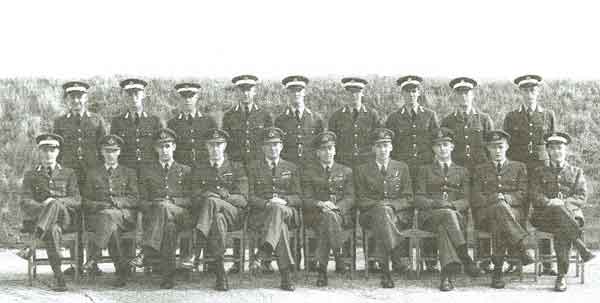
No.57 Fighter Controllers Course, Middle Wallop, September 1955.

I am on the front row, 4th from the left, with the two Wing Commanders to my right.

Derek Needham is on the back row, far right. In the background is one of the wartime

dispersal revetments.
and real training positions, as well as associated lecture and exhibition rooms.
Transport between sites, and for outside visits, was by RAF bus driven by a civilian
driver. I was not allowed to drive because I had only a Continental RAF licence and
had not yet taken a UK driving test.

It seemed strange to be driven by a civilian, but this was just one of the many
differences between 2
ATAF in Germany and the RAF in the UK. Another significant
difference was that instead of having a shared batman or batwoman, as had always
previously been the case, we had to do our own laundry, with a cleaner only
showing up periodically to dust and sweep our rooms. It didn't bother me greatly
but it was an inconvenient let-down. I also discovered that, with recent cutbacks in
funding, a permit had to be obtained to make an administrative phone call to
another RAF Station. Operational calls were likewise limited to those adjudged to be
essential but were otherwise not so closely monitored. Compared with my
experience of life in Germany, life in the UK was austere and it took me some time
to acclimatise.

Sqn.Ldr. 'Doug' Wilson was the
CO of the School of Fighter Control. He was supported by a team of instructors, among whom were Fg.Off. Honeychurch who
was a little too fond of scrumpy at times, Fg.Off. Jim (Jumbo) Cuthill who had been
one of my instructors at RAF Digby when I was there, and Flt.Lt. 'Dan' Archer.
2
These were further supported by WRAFs who were telephonists, tellers, and fighter
plotters, and
NCOs and Airmen from the technical trades. Additional to them was a
Flight of Balliol two-seater training aircraft, pilots and ground crew, whose task it
was to fly for, and be controlled by, us course students when learning the techniques
and skills of aircraft interception control - our prime reason for being on the course.
As if further to prove the point of the RAF being one big club or family, one of these
pilots was none other than Flt.Lt. Ken Knott who, as a Flight Sergeant, had been my
Flying Instructor at Wellesbourne Mountford and taken me through training up to
'Wings' level on Oxfords. Ken lived with his wife in a caravan parked on a remote
_____________________________________
2 Scrumpy = rough cider. A drink with a high alcohol content.
158








